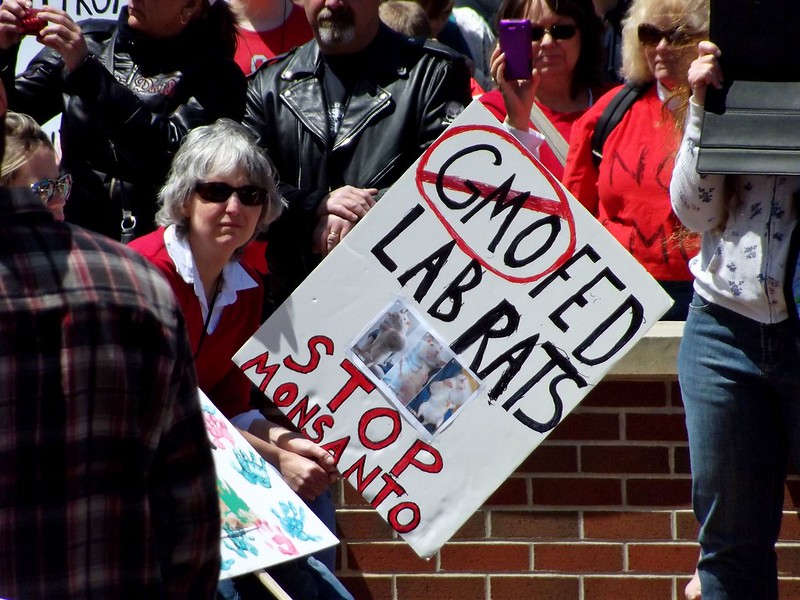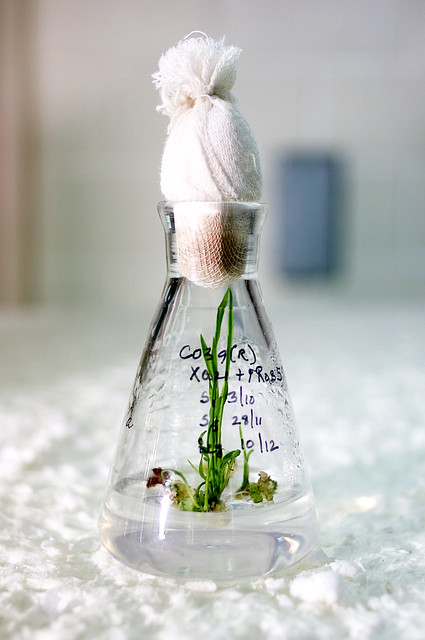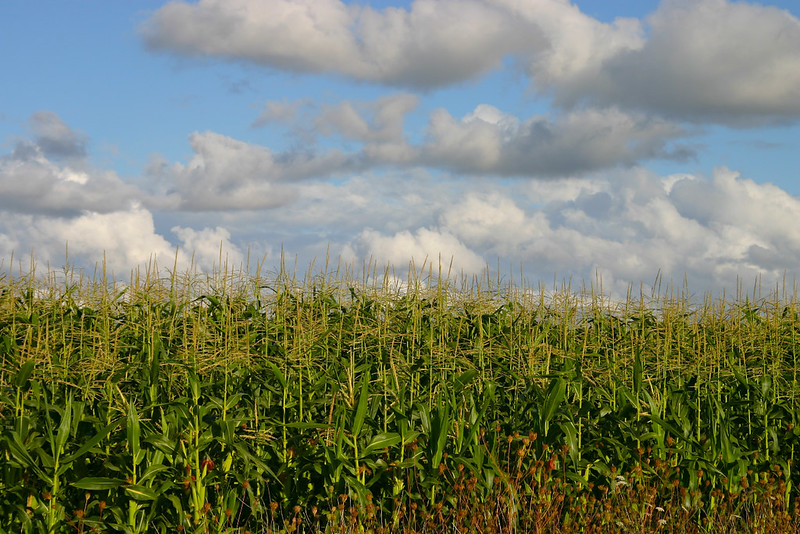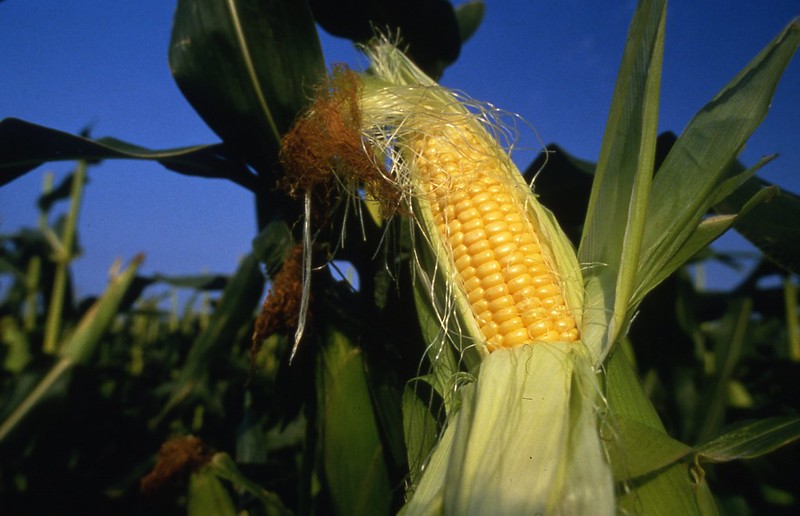In the near future, food made from genetically engineered
(GE) crops will be labeled, not because it will allow worried consumers to
avoid it, but because it will be the ethical choice at the grocery store.
Although the first generation of GE crops mainly focused on improving
production, with such enhanced traits as resistance to insects and herbicide
tolerance, the next generation of genetically engineered crops will be even better
for the environment and farm workers, requiring fewer harmful and expensive
chemical fertilizers and pesticides, and will have nutritional enhancements
that will directly benefit consumers and particularly the poorest of the poor
in food insecure countries.
 |
| Voluntary labeling: this soy sauce is clearly labeled as being made from soybeans that include genetically engineered varieties. |
The GE crop varieties of the near future will be adapted to
local climate and soil conditions, as well as local tastes and cultural idiosyncrasies.
As such, the new generation won’t solely be developed by large multinational
corporations like Monsanto, but also by local universities and small family-run businesses, and a
significant proportion of these biotech crops will be cultivated using
organic farming practices. With
public mistrust of biotechnology at an all-time high, these predictions seem
far-fetched. Fortunately, scientists and government agencies worldwide are very
aware of an urgent need for public education, which can ameliorate the spread
of misinformation and fearmongering threatening one of the greatest tools for
achieving the UN Millennium Development Goal of sustainably feeding a growing
global population.
 |
| Improving the nutritional quality of crops is a Millennium Development Goal. These conventionally bred orange-fleshed sweet potatoes are higher in vitamin A than non-orange fleshed varieties. (Picture credit: Bill & Melinda Gates Foundation.) |
The public perception is that there is raging controversy in
scientific circles on the safety and utility of GE crops, with researchers arguing
at the lab bench and in the field, and scientists locked in furious debate with
one another at scientific conferences. However, this is simply not true. There
is overwhelming scientific consensus on this issue (as there is on climate
change, evolution, and the benefits of vaccination). Those who claim there is
insufficient research on this topic are simply wrong. Many hundreds of peer-reviewed
scientific papers have been published on many aspects relating to the safety of
transgenic crops. The nonprofit GENERA
(Genetic Engineering Risk Atlas) project curates the most extensive and
complete database of these. The vast
majority of these studies (and I mean 99.9% of these, not just 51%) all come to
the same conclusion: the risks to human health from consuming food made from GE
crops are no different than those from consuming their conventional, non-GE
equivalents.
This seems like an odd way of saying GE crops are safe, but
the fact is that the very act of eating anything
carries a small amount of risk anyway. Apart from the risk of food-borne
bacterial infection (which can happen even with organic
produce), we forget that plants don’t really want to be eaten: potatoes
naturally produce a toxic alkaloid called solanine to protect themselves; celery
naturally produces psoralens, a type of chemical that can cause severe skin
burns; unless cassava, a staple crop for much of Africa, is properly prepared,
it can lead to cyanide poisoning; and even seemingly innocuous red kidney beans
are always served cooked, to deactivate a naturally produced protein called
phytohaemagglutinin which causes severe vomiting and diarrhea. Saying something
is good for you simply because it’s natural is a fallacy: arsenic is natural
and that’s clearly not something anyone wishes to put in their body. Using
biotechnology is just one way we can ensure our crops produce more of the
nutritional molecules we need, and
less of the harmful ones we don’t.
 |
| One way that cassava can be improved for human consumption is by reducing the amount of linamarin, a naturally occurring sugar that releases hydrogen cyanide when broken down by the digestive system. (Picture credit: Bill & Melinda Gates Foundation.) |
The leading scientific agencies, including the AAAS,
the National
Academies
of the United States, the European
Food Safety Authority, and the WHO
have issued very clear statements emphasizing the scientific consensus on
genetically engineered crops: the process of genetic engineering poses no
threat to human health, and farming of biotech crops can lead to great economic
and environmental benefits. Despite this comprehensive body of knowledge (and through
manipulation by the anti-GMO movement), the media has focused undue attention
on a very small number of studies that claim the opposite of the scientific
consensus on the risks GE crops pose to human health and the environment. This
is likely in an effort to ensure journalistic balance; however, there really
aren’t two sides to the science here. Almost invariably, these contrary studies
are exercises in bad science published in low-ranking journals by a few
dissident scientists, often with conflicts of interest. Giving this much
exposure to bad science can be downright dangerous: in the case of AIDS denialism, the South
African government’s adoption of the fringe cost many
human lives.
Thankfully, the South African government has since changed
its stance on antiretroviral therapy, but the German government has still not
approved the planting of MON810 corn (engineered with a bacterial protein that
prevents caterpillars from feeding on the plants, diminishing the need for
harmful chemical pesticides) despite the fact that the vast majority of
evidence suggests it poses no danger to non-target organisms. These regulatory
decisions were based on a very small number of poorly conceived or inconclusive
studies that could not subsequently be duplicated by other laboratories,
ignoring the vast number of scientifically rigorous studies that indicate that
these crops are harmless
to other insects.
 |
| A large body of scientific evidence indicates that corn engineered to be resistant to insects is safe for human consumption. |
Again, a few insubstantial bits of data cannot sufficiently
contradict a very large body of scientific knowledge and do not constitute
“scientific controversy”. Nevertheless, and quite understandably,
laypeople react emotionally to this perceived controversy, because it is
presented to them as whistleblowing by the news sources and environmental and
health blogs they trust. This makes otherwise rational people don honeybee
costumes and pretend to die in public
spaces in protest of GE crops (even though the use of engineered crops
instead of pesticides increases
biodiversity,
and there is mounting
evidence that a combination of pathogens and conventional pesticides may be
what’s truly decimating bee populations). People are protesting GE crops
because they feel they have been informed and need to be upset about something,
when what they should be upset about is how scientific ignorance is being
employed as leverage by special interest groups to divert attention and energy away
from what we really
need to be doing to fix the world’s food and agriculture systems.
At the March Against Monsanto held on the 25th of
May 2013 in various cities across the world, anti-GMO protesters held up images of
rats covered in large cancerous tumors, ostensibly caused by feeding on GE
corn. The images came from a 2012 paper by Gilles-Eric Séralini of CRIIGEN, an
anti-GMO group, and published in the journal Food and Chemical Toxicology. It
purported to provide evidence that consuming corn engineered with a bacterial
protein conferring tolerance to the herbicide glyphosate (sold by Monsanto
under the trade name Roundup) causes cancer. There were several serious problems with the
study, from bizarre statistical manipulation of the data, to insufficient
numbers of control rats. But the most glaring shortcoming was the fact that
none of those gruesome images of rats were accompanied by images of healthy
control rats. This is because the control rats (fed a non-genetically
engineered diet) also developed tumors: the strain of rat used in the study is
used to study chemotherapy drugs, and were bred to naturally develop tumors at
a very high incidence. They were entirely inappropriate for this kind of study,
and none of the data could be used to make the claims they tried to make. The Séralini
paper has now been thoroughly discredited by
several
scientists,
science
journalists
and scientific
agencies.
The whole fiasco is such a classic example of bad science that it now even has
its own Wikipedia entry.
However, a 2013 paper by Anthony Samsel and Stephanie Seneff, published
curiously enough in the small physics journal Entropy (note, not a
journal focusing on biology), again spurred alarming news reports.
This pseudoscientific paper claimed that Roundup is the cause of a mindboggling
array of diseases, including Parkinson’s disease, diabetes, and autism.
However, the Entropy paper was
written by authors who aren’t even biologists at all, documented no actual
experiments, and in fact cited Séralini’s discredited study as a reference for
a number of arguments they made. Again, this paper was adequately
debunked by scientists
and
journalists.
Dr Ariel Poliandri of the Cancer Division at Imperial College London promptly
compiled a useful
guide to detecting bogus research: in short, important research is
published in important journals. If it’s not, be wary. It’s interesting to note
that both these papers were published in low-tier pay-to-play journals with
inadequate peer review. If this was really the solid, groundbreaking work it
claimed to be, it would have been published in one of the big science journals,
whether open-access or not. This stuff all looks and sounds very “sciencey”,
but is not real science, and not only damages the good reputation of science in
the public eye, but is now having a dangerous influence on governmental policy
on GE crops all across the globe, with the governments of countries like Russia
and Kenya basing much of their biotech policy on the little trickle of bad science,
instead of the large volume of good science.
 |
| Even though it has been thoroughly discredited, anti-GMO protesters still use images from the infamous Séralini study. (Picture credit: Bill Baker.) |
In an idealized world uncoloured by political agenda, the
endeavours of science are neutral. Most scientists you’ll talk to about genetic
engineering are in fact neither opponents nor proponents of GE crops: they only
care about what the scientific evidence says. If the sum total of the
scientific evidence said otherwise, the scientific consensus would change. (Disclosure:
I am a plant scientist who studies the genes of cereals. I’m neither involved
in the production of transgenic crops, nor am I funded by any companies that
are.) It is not the job of scientists to increase public acceptance of genetic
engineering, it is the job of scientists to increase public trust in and
understanding of the scientific data: in this case the data overwhelmingly says
that GE crops are safe. But perhaps where science needs most help is in
explaining itself. The Proceedings of the National Academy of Sciences are
impenetrable to the public, but Dr. Oz gets beamed into every home with a
friendly smile and a whole dose of hokum. Everyone should have a basic level of
scientific literacy, so that we can stop expending so much energy on fighting misconceptions
about science. Recently British environmentalist Mark Lynas, who helped start
the anti-GMO movement in the 1990s, apologized
for demonizing agricultural biotechnology and feeding into anti-GMO
conspiracy theories, and some influential bloggers are also starting to let
go of old, misinformed points
of view. My hope is that sometime soon everyone will agree that biotech
crops, like organic farming practices, are part of a larger set of really
useful tools for sustainable agriculture.



